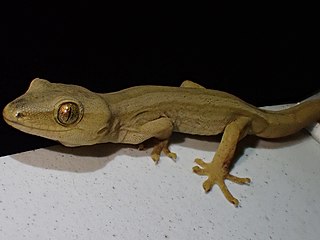
Hoplodactylus is a genus of geckos in the family Diplodactylidae. The genus is endemic to New Zealand, one of the seven genera of geckos found only in New Zealand. Hoplodactylus comprises two species of large to gigantic brownish lizards.

Rhacodactylus is a genus of medium to large geckos of the family Diplodactylidae. All species in this genus are found on the islands that make up New Caledonia.

The Northland green gecko, also known commonly as Gray's tree gecko is a species of lizard in the family Gekkonidae. The species is found only in the Northland region of New Zealand, north of Whangaroa; it is one of the rarest and most highly sought after lizards.

Duvaucel's gecko is a species of lizard in the family Diplodactylidae. The species is endemic to New Zealand.

Gigarcanum delcourti, formerly Hoplodactylus delcourti, is an extinct species of gecko in the family Diplodactylidae. It is the largest known of all geckos, with a snout-to-vent length (SVL) of 37 cm (14.6 in) and an overall length of at least 60 cm (23.6 in). It is only known from a single taxidermied specimen collected in the 19th century that was rediscovered unlabelled in a museum in France. The origin of the specimen was undocumented. While originally suggested to have been from New Zealand and the kawekaweau of Māori oral tradition, DNA evidence from the specimen suggests that it originates from New Caledonia.

The gold-striped gecko, gold-stripe gecko, or golden sticky-toed gecko is a species of gecko in the family Diplodactylidae. It is endemic to New Zealand, and is only found in the Taranaki region and Mana Island. The holotype is in the collection of the Museum of New Zealand Te Papa Tongarewa.

The black-eyed gecko, also known commonly as Whitaker's sticky-toed gecko, is a species of lizard in the family Diplodactylidae. An alpine gecko species, discovered in 1970, it inhabits high-altitude mountains in three areas of the South Island of New Zealand. It is the highest-altitude lizard species in New Zealand, living up to 2,200 m (7,200 ft) above sea level.

The harlequin gecko, formerly Hoplodactylus rakiurae, is a species of gecko, a lizard in the family Diplodactylidae. The species is endemic to Stewart Island/Rakiura in the far south of New Zealand, where it was discovered in 1969. In terms of distribution it is one of the southernmost gecko species in the world.

The Stephen's Island gecko, also known commonly as the Cook Strait striped gecko, Stephen's sticky-toed gecko, and the striped gecko, is a species of gecko in the genus Toropuku in the family Diplodactylidae. The species is endemic to New Zealand.

Woodworthia maculata, also known as the New Zealand common gecko or Raukawa gecko, is a species in the family Diplodactylidae. The specific name maculata means "speckled".

The Diplodactylidae are a family in the suborder Gekkota (geckos), with over 150 species in 25 genera. These geckos occur in Australia, New Zealand, and New Caledonia. Diplodactylids are the most ecologically diverse and widespread family of geckos in both Australia and New Caledonia, and are the only family of geckos found in New Zealand. Three diplodactylid genera have recently been split into multiple new genera.

Lucasium is a genus of lizards, sometimes called ground geckos, in the family Diplodactylidae. The genus is endemic to Australia, and it includes 14 species.

Mokopirirakau is a genus of geckos in the family Diplodactylidae. Mokopirirakau is endemic to New Zealand. Mokopirirakau, meaning "forest gecko", is derived from the Māori language.
Paniegekko is a monotypic genus of geckos in the family Diplodactylidae, containing the species Paniegekko madjo. It is endemic to humid montane forests on Mont Ignambi and Mont Panié in the Panié massif of New Caledonia. It was once considered a species of Bavayia, a similar genus of arboreal geckos. Paniegekko madjo is endangered, owing to predation by introduced rodents and cats combined with habitat degradation by wildfires and introduced pigs and deer. It has not been observed since 1998.
Oedura argentea is a species of velvet gecko that has been recently described from the sandstone ranges of central-north Queensland, Australia.

Pygopodoidea is a gecko superfamily and the only taxon in the gekkotan subclade Pygopodomorpha. The clade includes three Australasian families: Diplodactylidae, Carphodactylidae, and Pygopodidae. Traditional gekkotan systematics had considered Diplodactylidae and Carphodactylidae as subfamilies of the family Gekkonidae, but recent molecular work have placed Pygopodidae within Gekkonidae making it paraphyletic. These analyses have shown support of Pygopodidae and Carphodactylidae being sister taxa, with Diplodactylidae occupying a basal position in Pygopodoidea.
The Aupōuri green gecko, also known as the North Cape green gecko or yellow-lipped green gecko, is a species of gecko in the family Diplodactylidae. While the existence of the species was known for many years, it was undescribed until early 2021, with its scientific name being Naultinus 'North Cape' prior to description as N. flavirictus.

The korowai gecko, also known as the Muriwai gecko, is a gecko found on the west coast of the Auckland Region of New Zealand. First discovered on Oaia Island in 1954, the species was recognised as distinct from Woodworthia maculata in 2016, and was formally described in 2023. Only 32 individuals are known to exist as of 2023, all within a very restricted range, on Te Korowai-o-Te-Tonga Peninsula, Muriwai Beach, Muriwai Regional Park and Oaia Island.

Oaia Island is an island on the west coast of the Auckland Region, New Zealand, near Muriwai. Home to an Australasian gannet colony, the island was traditionally used as a seasonal food resource for Tāmaki Māori iwi, including Te Kawerau ā Maki. Over the 21st century, the gannet population grew significantly, which had a negative impact on the island's flora, and led to gannets colonising areas of the Muriwai mainland. The island is a known location where the rare korowai gecko has been found.














